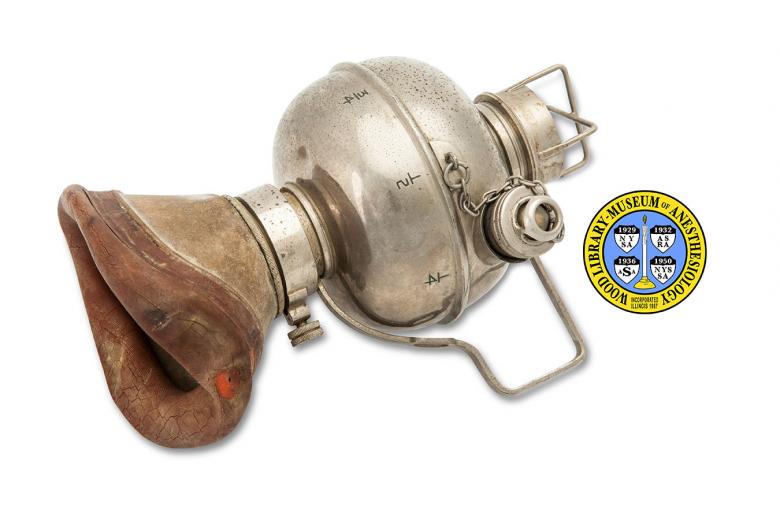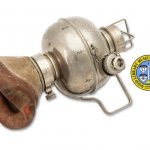Hewitt Wide-Bore Inhaler
Sir Frederick William Hewitt (1857-1916), an accomplished English anesthesiologist, wrote one of the earliest comprehensive textbooks on anesthesia, and designed several pieces of anesthesia equipment. In 1901, he described his wide-bore ether inhaler, a modification of the Clover Ether Inhaler. Unlike the Clover, it can be refilled with ether while still in use, and the mask is screwed into place so that it "cannot be unexpectedly detached." Most importantly, it admitted a larger volume of air, making it easier for the patient to breathe. That, in turn, speeded induction (the first stage of inhalation anesthesia). This example of the wide-bore inhaler was made by the original manufacturer, Barth & Co. of London.
Throughout his career, Dr. Hewitt called attention to the need for adequate ventilation and oxygenation of the patient. His oral airway, introduced in 1908, led the way to making control of the airway a routine part of the anesthesiologist’s work. He was so highly respected that he was appointed the official Anesthetist to King Edward VII, and later to King George V.
Catalog Record: Hewitt Wide-Bore Inhaler
Access Key: akdi
Accession No.: 1999-06-28-1
Title: [Hewitt’s modification of Clover’s portable regulating ether inhaler / designed by Frederic W. Hewitt.]
Author: Hewitt, Frederic William, Sir, 1857-1916.
Title variation: Alt Title
Title: Modification of Clover’s portable regulating inhaler.
Title variation: Alt Title
Title: Hewitt wide-bore inhaler.
Title variation: Alt Title
Title: Hewitt’s wide-bore inhaler.
Title variation: Alt Title
Title: Hewitt large-bore ether inhaler.
Title variation: Alt Title
Title: Hewitt’s improved lage bore inhaler.
Title variation: Alt Title
Title: Hewitt’s ether inhaler.
Title variation: Alt Title
Title: Hewitt wide-bore inhaler.
Publisher: London: Geo. Barth & Co., [1901-1935].
Physical Descript: 1 inhaler : metal, leather, rubber; 17.5 x 16 x 19.5 cm.
Subject: Inhalers, Anesthesia – Great Britain.
Subject: Anesthesia, Inhalation – instrumentation.
Subject: Ether, Ethyl.
Subject: Hewitt, Frederic William, Sir, 1857-1916.
Note Type: General
Notes: Title based on the designer’s name for the device. In the 1901 edition of his
textbook, Hewitt called this “the author’s modification of Clover’s
regulating inhaler.” “Hewitt’s” replaced “the author’s” for the title. The
alternate titles come from other author’s name for the device, Boyle, 1907,
Gardener, 1916 and Luke, 1905.
Note Type: General
Notes: The early year (1901) in the date range for the possible year of manufacture
is based on the year that Sir Frederic Hewitt first described it in a
published document. The late year (1935) in the date range for the possible
year of manufacture is generously based on the latest date for which the
company “Geo. Barth & Co” was referenced (Lawrence & Lawrence, 1987). The
date range could change if documentation indicates the range should be
corrected.
Note Type: Citation
Notes: Boyle HEG. Ether. Practical Anaesthetics. London: Henry Frowde; 1907:69.
Note Type: Citation
Notes: Edwards G. Frederic William Hewitt (1857-1916). Ann R Coll Surg Engl.
1951;8(3):233-245. https://www.ncbi.nlm.nih.
gov/pmc/articles/PMC2238538/pdf/annrcse00045-0065.pdf. Accessed September 13,
2013.
Note Type: Citation
Notes: Gardner HB. Ether. A Manual of Surgical Anaesthesia. New York: Willim Wood &
Company; 1916:127-131.
Note Type: Citation
Notes: Hewitt FW. Anaesthetics and their Administration. London: Macmillan and Co.;
1901:278.
Note Type: Citation
Notes: Hewitt FW. Anaesthetics and their Administration. London: Macmillan and Co.;
1907:334.
Note Type: Citation
Notes: Hewitt F. Clinical observations upon respiration during anaesthesia. Proc Roy
Med Chirurg Soc. London. 1891;3(Siii)31-38.
Note Type: Citation
Notes: Hewitt F. Further observations on the use of oxygen with nitrous oxide. J Br
Dent Assoc. June 15, 1894:15(6):380-387.
Note Type: Citation
Notes: Hewitt F. The proposed legislation in regard to anaesthetics. Br Med J. Br
Med J. July 10, 1909;2(2532):113–114.
Note Type: Citation
Notes: Hewitt F. Proposed legislation on anaesthetics. Br Med J. December 25,
1909;2(2556):1825–1826.
Note Type: Citation
Notes: Lawrence C, Lawrence G. No Laughing Matter: Historical Aspects of Anaesthesia
London: Wellcome Institute for the History of Medicine/Science Museum;
1987:57.
Note Type: Citation
Notes: Luke TD. Ether. A Guide to Anaesthetics. Edinburgh: William Green & Sons;
1905:33-35.
Note Type: Citation
Notes: McGoldrick KE. Sir Frederic William Hewitt: the man and his airway. ASA Newsl
2008;72(9):10-13.
Note Type: Citation
Notes: Royal Medical & Chirurgical Society [summary of meeting]: clinical
observations upon respiration during anaesthesia. Lancet. December 13,
1890;2:1270.
Note Type: Physical Description
Notes: One metal anesthesia inhaler, with a metal and red rubber mask; The body of
the inhaler is round, with the entrance for air on one end and the connection
to the mask on the other; An opening to add ether extends from the side of
the inhaler; A bar cane be rotated to several markings on the outside of the
inhaler; The markings are, “0”, “1/4”, “1/2”, “3/4”, and “FULL”; Also
engraved onto the inhaler in cursive letting is, “Geo. Barth & Co. London”;
Below that is, “Sole Makers”; The surface of the metal is dotted with
corrosion; The mask measures approximately 12.5 x 8.5 x 2 cm; Stamped on the
rubber with “MADE IN ENGLAND”; The rubber is dry and hard.
Note Type: Reproduction
Notes: Photographed by Mr. Steve Donisch on January 16, 2013.
Note Type: Historical
Notes: Sir Frederic W. Hewitt (1857-1916), an accomplished and well respected
English anesthesiologist, was an expert in the function and use of the Clover
Ether Inhaler. In 1901, Hewitt described his modification of the Clover
Inhaler. Often referred to as the Hewitt Wide-Bore Inhaler, Dr. Hewitt
introduced changes in order to make it easier to breathe through the device
and improve the ventilation of oxygen and carbon dioxide.
Throughout his career, Hewitt called attention to the dangers of inadequate
ventilation and oxygenation, and strove to improve the delivery of fresh air
and oxygen to anesthesia patients. This lifelong objective was apparent in
his writing and inventions. For examples, one may read a summary of his 1890
presentation titled, “Clinical Observations upon Respiration during
Anaesthesia,” or consider his innovative oxygen and nitrous oxide apparatus
of 1894 and his groundbreaking oral airway of 1908.
Hewitt also advocated for better education of medical students in the subject
of anesthesia. He lobbied within and outside of his profession for higher
standards in the delivery of anesthesia care, and even persuaded lawmakers to
propose legislation to prohibit the administration of anesthetics by
unqualified providers.
Additionally, he was the author of one of the earliest comprehensive
textbooks on anesthesia. Titled “Anaesthetics and their Administration,” five
editions of the text were eventually published.
In 1901, Hewitt was recruited to anesthetize King Edward VII for emergency
abdominal surgery. This was just a day or so before the new King was to be
coronated. He recovered well, and Hewitt became the first anesthesiologist
ever to be knighted.
We encourage readers to compare this inhaler to Dr. Joseph Clover’s portable
ether inhaler.
Note Type: Publication
Notes: Ball C. Hewitt’s nitrous oxide-oxygen inhaler. Anaesth Intensive Care. 1993
Dec;21(6):733.
Note Type: Publication
Notes: Howat DD. Sir Frederic William Hewitt MVO MD. J Med Biogr. 2000;8(2):123.
Note Type: Publication
Notes: Howat DD. Sir Frederic William Hewitt MVO MD. Part I: early life and work on
nitrous oxide. J Med Biogr. 1999;7(1):5-10.
Note Type: Publication
Notes: Howat DD. Sir Frederic William Hewitt MVO MD. Part II: the Anaesthetic Bill
and professional and private life. J Med Biogr. 1999;7(2):63-68.
Note Type: Publication
Notes: Galley AH, King AC. Modifications of Clover’s ether inhaler. Anaesthesia.
1948;3(4):147-154.
Note Type: Publication
Notes: McGoldrick KE. Sir Frederic William Hewitt: his multifaceted contributions to
anesthesiology. In: Askitopoulou H, ed. History of Anaesthesia VII.
Herakleion: Crete University Press, 2012:491-500.
Note Type: Publication
Notes: Maltby JR. Frederic Hewitt Lecture: Sir Frederic William Hewitt (1857-1916)
Notable Names in Anaesthesia. London: Royal Society of Medicine Press;
2002:87-90.
Note Type: Exhibition
Notes: Displayed in the museum gallery with regulated inhalers beginning May, 2011;
Chosen for the WLM website (noted June 10, 2013).


